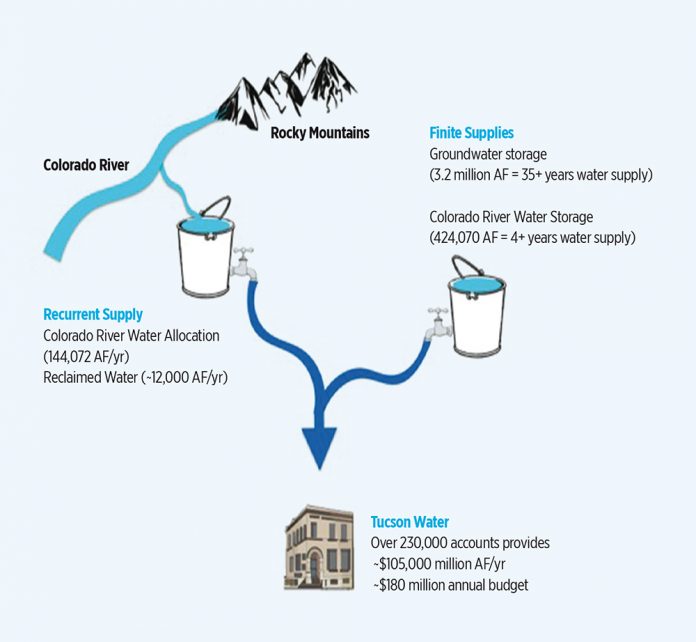How a US landlocked desert city is strategically storing water to drought-proof the future
By Amy McCoy*
The US state of Arizona is acutely aware of the threats to its water scarcity. At its heart lies the Sonoran Desert with the state dependent on a shrinking, over-allocated Colorado River. Arizona has depleted groundwater reserves and a climate that is growing hotter and drier. There’s no sea to desalinate yet people keep coming.
So how does a growing urban population thrive here?
First, it had to hit a wall. For decades, unmanaged pumping had depleted aquifers and caused land subsidence in Arizona’s largest cities Tucson and Phoenix. The 1980 Groundwater Management Act ended that, set priorities, and unlocked new doors. That Act required 100-year “Assured Water Supplies” for municipalities in the urban core of the state, and freed Arizona to tap Federal funding for infrastructure that delivers a share (1.5 million acre-feet per year) of the Colorado River through the Central Arizona Project (CAP).
Soon, CAP delivery became the cornerstone of Arizona’s water management portfolio. It helps offset groundwater pumping, augment aquifer storage, and support agriculture, tribes, and growing cities. These proactive, long- range adaptive responses secure water in a state defined by hydrologic instability.
Then it had to pass a test. Earlier this year Lake Mead, the state’s primary reservoir, shrank to one foot above the water level, which threatened to trigger a federal ‘Declaration of Shortage.’ If that happened, Arizona would immediately lose access to as much as 40 percent of its Colorado River supply. People hoped for rain, and a “May miracle” bolstered reservoir levels enough to allow 18-24 months to craft a solution that would avert a devastating crisis.
But that left a catch. The same regulations that encouraged long-term flexibility to shore up the water supply options, now imposed rigidity on where and when Colorado River water is delivered. The system combines with drought-driven uncertainties to divert surface water into local, long-term underground storage vaults, which is good but it paradoxically prevents reservoir storage that could avoid a Declaration of Shortage.

So the authorities looked to recharge its aquifers into storage banks. This groundwater savings culture is exemplified by Tucson, which annually uses only two-thirds of its river allocation, and has recharged the remaining 44,000 acre- feet per year (or 5 months of supply) as underground storage. Additional savings from Tucson Water’s conservation programme bolster the general municipal supply reserves.
By steadily reducing municipal demand each year, Tucson Water has ‘deposited’ more CAP supplies while reducing groundwater ‘withdrawals,’ building four decades worth of reserve supply. The annual surpluses may even increase in the years ahead. Part of the downward demand trend is due to household and commercial conservation efforts, but efficient fixtures and community values are also playing a role.
The striking contrast between urban abundance within a water scarce basin places Tucson in an uncommon position. By running such a successful conservation programme that, beyond just accumulating water savings in the supply ledger (forestalling a Shortage Declaration), Tucson now has the opportunity to ‘lend’ or ‘reinvest’ its annual water surplus (in combination with rainwater, stormwater, and reclaimed water) into community, institutional, and environmental outcomes that shift the city towards autonomy and independence from the larger Colorado River system.
One worthy investment would be to recover the shallow groundwater tables that support riparian vegetation and stream flows through Tucson Water well management.
Another investment could support green infrastructure projects with the potential to mitigate flooding, increase natural infiltration after precipitation events, and avoid the need for additional expensive grey infrastructure development.
This investment would additionally support expanded shade tree coverage and mitigate heat island effects, lower night-time temperatures, and provide a range of safety, air quality, water savings, and health benefits. Similar benefits from small-scale efforts to date are evident in Tucson and of increasing interest to Pima County and the Pima Association of Governments.
But the highest yields may come from investing in thought leadership. Tucson’s relatively secure water portfolio could apply lessons learned within the municipality to innovate market-based approaches on regional water allocation that offset the risk posed to other water users.
As Lake Mead declines, and a shortage in the Lower Basin looms, Tucson’s example offers agility and flexibility as the antidote to uncertainty.








